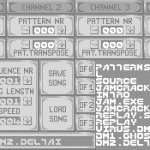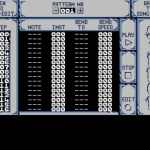|
|
By Peter Swimm, on August 24th, 2009  Anders from Chipflip has linked to an interesting interview he conducted with Metin Seven, one of the developers of SIDMon. In it, they discuss the transition from c64 to amiga, and the retro-origin of the intial use of the chiptune term. Great read! Anders from Chipflip has linked to an interesting interview he conducted with Metin Seven, one of the developers of SIDMon. In it, they discuss the transition from c64 to amiga, and the retro-origin of the intial use of the chiptune term. Great read!
AC: Hi Metin. I’m a tracker musician researching the history of chipmusic for a master thesis. Currently I’m looking the epistemology of the word chipmusic or chiptune. Since you were involved with SIDmon the first synthetic Amiga tracker, right? I wanted to ask if you have any memories of this.Hi Anders. That’s the coolest master thesis subject I’ve heard of so far.
:-SIDmon was indeed the first synth audio editor for the Commodore Amiga. Its name refers to the legendary MOS Technology 6581/8580 SID Sound Interface Device chip, best known from the equally legendary Commodore 64 home computer, the Amiga’s predecessor in terms of Commodore flagships. The “mon” part of SIDmon refers to “monitor” and was inspired by the first music tracker I can remember: Soundmon for the Commodore 64.SIDmon’s interface was primitively designed compared to today’s design standards, SIDmon’s graphics reflected the game-oriented 2D graphics style of those days. It was divided in four parts: a waveform editor for creating synth sounds, a sound sample editor, a pattern editor for arranging the sounds into music patterns, and a song editor where you could combine the patterns into a four-channel song.
via Metinsevendotcom
By Peter Swimm, on August 21st, 2009  Johan Kotlinski (he of LSDJ fame) wrote a extensive overview of Amiga Music programs for a college course. It ahs now been translated to english and posted on chipflip: Johan Kotlinski (he of LSDJ fame) wrote a extensive overview of Amiga Music programs for a college course. It ahs now been translated to english and posted on chipflip:
As it was written for a technoculture-course at university, there is a relatively extensive historiography of the early demoscene and how it evolved from cracking. This means that the specific Amiga software part starts only half-way through the text. It starts with describing the brief birth of Amiga-trackers in the commercial sphere: Soundtracker didn’t sell well but was reverse engineered and appropriated in the demoscene. It became the dominant software on Amiga, and set standards still used in contemporary trackers such as Renoise.
via CHIPFLIP.
By B00daW, on July 21st, 2009 Neil Baldwin over at Duty Cycle Generator has added the ability in his sound engine “Nijuu” to add an “echo effect” to a single square wave channel.
Echo Demo
How it works is to have a circular buffer (one each for voices Square 1, Square 2 & Noise) that the echo writes to by figuring out what is going to get written to the PAPU (Pseudo Audio Processing Unit) registers each frame. It then captures the register settings and continues to do so until the buffer is filled, then starts again at the beginning. When you enable echo, Nijuu retrieves the values from the buffer and writes them to the PAPU registers in the “gaps” in between notes when it decides that there’s no activity on the voice (I do this by detecting if the ADSR envelope on the voice has reached the release phase or if there is no note playing). The echo feedback continues to loop around, attenuating the captured amplitude until it reaches zero. All the while, any new notes are captured to the echo buffer in the same way and it continues to capture/attenuate/feedback notes forever until you turn it off.
(The above quote was taken from Neil’s article and slightly modified for accuracy.)
By Peter Swimm, on July 15th, 2009 After teasing it in past updates, Neil Baldwin reveals the secret Terry Jones project that never saw the light of day, a adaptation of the film Erik The Viking (perhaps the last enjoyable Tim Robbins movie?)
Neil writes:
We were producing the game for the now-defunct Japanese publisher, Video Systems and had pretty much completed the whole game. However, geographical and language problems made the testing and bug-finding phase frustratingly difficult. We were almost solely reliant on the publisher finding bugs/issues simply because there was only 4 of us trying to deliver this fairly large and complicated game and as we didn’t speak Japanese and they didn’t speak much English, it made for an interesting process. Even I had to get involved in map building and putting together trigger/behaviour scripts for the game’s events as well as writing all the music. It was all good fun though and the last version of the game that we submitted to the publisher was in great shape and actually good fun to play!
…
Luckily for you lot, I still had the music binary files and, with a little manual hex editing, managed to fashion it into a NSF file so even if you can’t see the game, you can listen to the music. I am far too good to you all :)
via Duty Cycle Generator – NES Music by Neil Baldwin.
By lazerbeat, on June 30th, 2009  Ed: Here is Part II of TCTD’s interview with Goto80. You can catch Part I here. Thanks to Billy_R for the photo Ed: Here is Part II of TCTD’s interview with Goto80. You can catch Part I here. Thanks to Billy_R for the photo
LB – Did you have any specific objective in mind when you released Papaya? Were you looking to bring your music to a wider audience, to bring the C64 into clubs?
GT80 – Not really, no. I just thought it was fun to release a 7″. The first idea was to make an album with covers of cheesy 80s music, like my previous cassette release, but I was happy I settled with the Papaya. It’s a cover of a Swedish 80s schlager song, and it haunted me or many years. But yeah, the record received attention from all kinds of directions. I remember that I felt like an unwilling ambassador for C64-music. Lots of talented people remained unknown to most, but now I know that most of those people just don’t want to be famous or play live. Demosceners are a lot like that, it seems.
LB – You said “Made on the Internet” was “the best thing I’ve made so far“, bearing in mind you had released over 1000 tunes by 2007 how did you pick MOTI as your favorite up until that point?
Continue reading Goto80 interview pt 2
|
|
 Anders from Chipflip has linked to an interesting interview he conducted with Metin Seven, one of the developers of SIDMon. In it, they discuss the transition from c64 to amiga, and the retro-origin of the intial use of the chiptune term. Great read!
Anders from Chipflip has linked to an interesting interview he conducted with Metin Seven, one of the developers of SIDMon. In it, they discuss the transition from c64 to amiga, and the retro-origin of the intial use of the chiptune term. Great read!






Comments